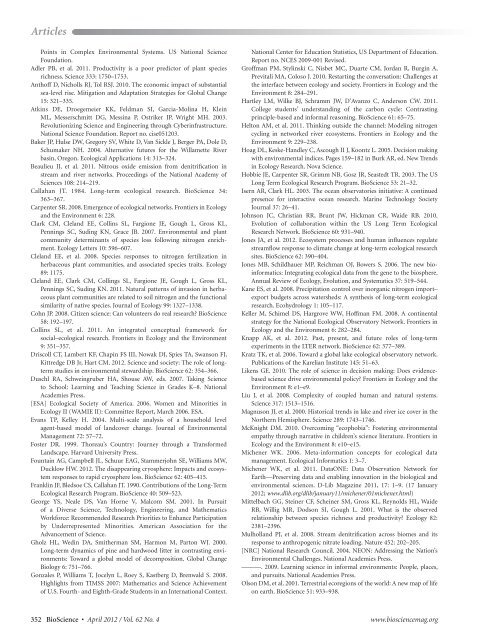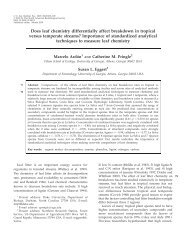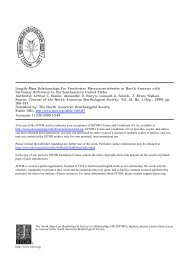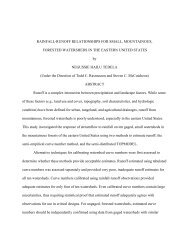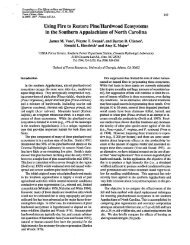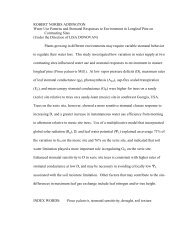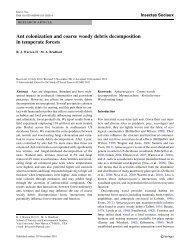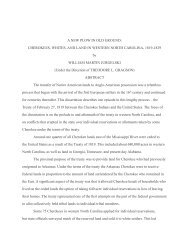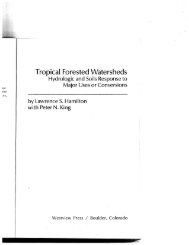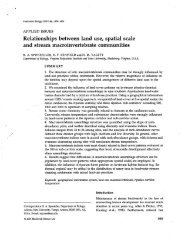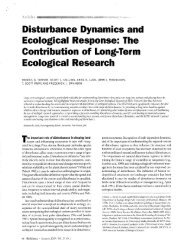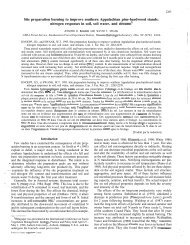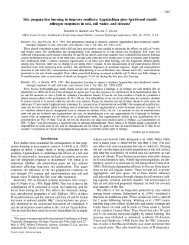biology join - Coweeta LTER - University of Georgia
biology join - Coweeta LTER - University of Georgia
biology join - Coweeta LTER - University of Georgia
You also want an ePaper? Increase the reach of your titles
YUMPU automatically turns print PDFs into web optimized ePapers that Google loves.
Articles<br />
Points in Complex Environmental Systems. US National Science<br />
Foundation.<br />
Adler PB, et al. 2011. Productivity is a poor predictor <strong>of</strong> plant species<br />
richness. Science 333: 1750–1753.<br />
Anth<strong>of</strong>f D, Nicholls RJ, Tol RSJ. 2010. The economic impact <strong>of</strong> substantial<br />
sea-level rise. Mitigation and Adaptation Strategies for Global Change<br />
15: 321–335.<br />
Atkins DE, Droegemeier KK, Feldman SI, Garcia-Molina H, Klein<br />
ML, Messerschmitt DG, Messina P, Ostriker JP, Wright MH. 2003.<br />
Revolutionizing Science and Engineering through Cyberinfrastructure.<br />
National Science Foundation. Report no. cise051203.<br />
Baker JP, Hulse DW, Gregory SV, White D, Van Sickle J, Berger PA, Dole D,<br />
Schumaker NH. 2004. Alternative futures for the Willamette River<br />
basin, Oregon. Ecological Applications 14: 313–324.<br />
Beaulieu JJ, et al. 2011. Nitrous oxide emission from denitrification in<br />
stream and river networks. Proceedings <strong>of</strong> the National Academy <strong>of</strong><br />
Sciences 108: 214–219.<br />
Callahan JT. 1984. Long-term ecological research. BioScience 34:<br />
363–367.<br />
Carpenter SR. 2008. Emergence <strong>of</strong> ecological networks. Frontiers in Ecology<br />
and the Environment 6: 228.<br />
Clark CM, Cleland EE, Collins SL, Fargione JE, Gough L, Gross KL,<br />
Pennings SC, Suding KN, Grace JB. 2007. Environmental and plant<br />
community determinants <strong>of</strong> species loss following nitrogen enrichment.<br />
Ecology Letters 10: 596–607.<br />
Cleland EE, et al. 2008. Species responses to nitrogen fertilization in<br />
herbaceous plant communities, and associated species traits. Ecology<br />
89: 1175.<br />
Cleland EE, Clark CM, Collings SL, Fargione JE, Gough L, Gross KL,<br />
Pennings SC, Suding KN. 2011. Natural patterns <strong>of</strong> invasion in herbaceous<br />
plant communities are related to soil nitrogen and the functional<br />
similarity <strong>of</strong> native species. Journal <strong>of</strong> Ecology 99: 1327–1338.<br />
Cohn JP. 2008. Citizen science: Can volunteers do real research? BioScience<br />
58: 192–197.<br />
Collins SL, et al. 2011. An integrated conceptual framework for<br />
social–ecological research. Frontiers in Ecology and the Environment<br />
9: 351–357.<br />
Driscoll CT, Lambert KF, Chapin FS III, Nowak DJ, Spies TA, Swanson FJ,<br />
Kittredge DB Jr, Hart CM. 2012. Science and society: The role <strong>of</strong> longterm<br />
studies in environmental stewardship. BioScience 62: 354–366.<br />
Duschl RA, Schweingruber HA, Shouse AW, eds. 2007. Taking Science<br />
to School: Learning and Teaching Science in Grades K–8. National<br />
Academies Press.<br />
[ESA] Ecological Society <strong>of</strong> America. 2006. Women and Minorities in<br />
Ecology II (WAMIE II): Committee Report, March 2006. ESA.<br />
Evans TP, Kelley H. 2004. Multi-scale analysis <strong>of</strong> a household level<br />
agent-based model <strong>of</strong> landcover change. Journal <strong>of</strong> Environmental<br />
Management 72: 57–72.<br />
Foster DR. 1999. Thoreau’s Country: Journey through a Transformed<br />
Landscape. Harvard <strong>University</strong> Press.<br />
Fountain AG, Campbell JL, Schuur EAG, Stammerjohn SE, Williams MW,<br />
Ducklow HW. 2012. The disappearing cryosphere: Impacts and ecosystem<br />
responses to rapid cryosphere loss. BioScience 62: 405–415.<br />
Franklin JF, Bledsoe CS, Callahan JT. 1990. Contributions <strong>of</strong> the Long-Term<br />
Ecological Research Program. BioScience 40: 509–523.<br />
George YS, Neale DS, Van Horne V, Malcom SM. 2001. In Pursuit<br />
<strong>of</strong> a Diverse Science, Technology, Engineering, and Mathematics<br />
Workforce: Recommended Research Priorities to Enhance Participation<br />
by Underrepresented Minorities. American Association for the<br />
Advancement <strong>of</strong> Science.<br />
Gholz HL, Wedin DA, Smitherman SM, Harmon M, Parton WJ. 2000.<br />
Long-term dynamics <strong>of</strong> pine and hardwood litter in contrasting environments:<br />
Toward a global model <strong>of</strong> decomposition. Global Change<br />
Biology 6: 751–766.<br />
Gonzales P, Williams T, Jocelyn L, Roey S, Kastberg D, Brenwald S. 2008.<br />
Highlights from TIMSS 2007: Mathematics and Science Achievement<br />
<strong>of</strong> U.S. Fourth- and Eighth-Grade Students in an International Context.<br />
National Center for Education Statistics, US Department <strong>of</strong> Education.<br />
Report no. NCES 2009-001 Revised.<br />
Gr<strong>of</strong>fman PM, Stylinski C, Nisbet MC, Duarte CM, Jordan R, Burgin A,<br />
Previtali MA, Coloso J. 2010. Restarting the conversation: Challenges at<br />
the interface between ecology and society. Frontiers in Ecology and the<br />
Environment 8: 284–291.<br />
Hartley LM, Wilke BJ, Schramm JW, D’Avanzo C, Anderson CW. 2011.<br />
College students’ understanding <strong>of</strong> the carbon cycle: Contrasting<br />
principle-based and informal reasoning. BioScience 61: 65–75.<br />
Helton AM, et al. 2011. Thinking outside the channel: Modeling nitrogen<br />
cycling in networked river ecosystems. Frontiers in Ecology and the<br />
Environment 9: 229–238.<br />
Hoag DL, Keske-Handley C, Ascough II J, Koontz L. 2005. Decision making<br />
with environmental indices. Pages 159–182 in Burk AR, ed. New Trends<br />
in Ecology Research. Nova Science.<br />
Hobbie JE, Carpenter SR, Grimm NB, Gosz JR, Seastedt TR. 2003. The US<br />
Long Term Ecological Research Program. BioScience 53: 21–32.<br />
Isern AR, Clark HL. 2003. The ocean observatories initiative: A continued<br />
presence for interactive ocean research. Marine Technology Society<br />
Journal 37: 26–41.<br />
Johnson JC, Christian RR, Brunt JW, Hickman CR, Waide RB. 2010.<br />
Evolution <strong>of</strong> collaboration within the US Long Term Ecological<br />
Research Network. BioScience 60: 931–940.<br />
Jones JA, et al. 2012. Ecosystem processes and human influences regulate<br />
streamflow response to climate change at long-term ecological research<br />
sites. BioScience 62: 390–404.<br />
Jones MB, Schildhauer MP, Reichman OJ, Bowers S. 2006. The new bioinformatics:<br />
Integrating ecological data from the gene to the biosphere.<br />
Annual Review <strong>of</strong> Ecology, Evolution, and Systematics 37: 519–544.<br />
Kane ES, et al. 2008. Precipitation control over inorganic nitrogen import–<br />
export budgets across watersheds: A synthesis <strong>of</strong> long-term ecological<br />
research. Ecohydrology 1: 105–117.<br />
Keller M, Schimel DS, Hargrove WW, H<strong>of</strong>fman FM. 2008. A continental<br />
strategy for the National Ecological Observatory Network. Frontiers in<br />
Ecology and the Environment 6: 282–284.<br />
Knapp AK, et al. 2012. Past, present, and future roles <strong>of</strong> long-term<br />
experiments in the <strong>LTER</strong> network. BioScience 62: 377–389.<br />
Kratz TK, et al. 2006. Toward a global lake ecological observatory network.<br />
Publications <strong>of</strong> the Karelian Institute 145: 51–63.<br />
Likens GE. 2010. The role <strong>of</strong> science in decision making: Does evidencebased<br />
science drive environmental policy? Frontiers in Ecology and the<br />
Environment 8: e1–e9.<br />
Liu J, et al. 2008. Complexity <strong>of</strong> coupled human and natural systems.<br />
Science 317: 1513–1516.<br />
Magnuson JJ, et al. 2000. Historical trends in lake and river ice cover in the<br />
Northern Hemisphere. Science 289: 1743–1746.<br />
McKnight DM. 2010. Overcoming “ecophobia”: Fostering environmental<br />
empathy through narrative in children’s science literature. Frontiers in<br />
Ecology and the Environment 8: e10–e15.<br />
Michener WK. 2006. Meta-information concepts for ecological data<br />
management. Ecological Informatics 1: 3–7.<br />
Michener WK, et al. 2011. DataONE: Data Observation Network for<br />
Earth—Preserving data and enabling innovation in the biological and<br />
environmental sciences. D-Lib Magazine 2011, 17: 1–9. (17 January<br />
2012; www.dlib.org/dlib/january11/michener/01michener.html)<br />
Mittelbach GG, Steiner CF, Scheiner SM, Gross KL, Reynolds HL, Waide<br />
RB, Willig MR, Dodson SI, Gough L. 2001. What is the observed<br />
relationship between species richness and productivity? Ecology 82:<br />
2381–2396.<br />
Mulholland PJ, et al. 2008. Stream denitrification across biomes and its<br />
response to anthropogenic nitrate loading. Nature 452: 202–205.<br />
[NRC] National Research Council. 2004. NEON: Addressing the Nation’s<br />
Environmental Challenges. National Academies Press.<br />
———. 2009. Learning science in informal environments: People, places,<br />
and pursuits. National Academies Press.<br />
Olson DM, et al. 2001. Terrestrial ecoregions <strong>of</strong> the world: A new map <strong>of</strong> life<br />
on earth. BioScience 51: 933–938.<br />
352 BioScience • April 2012 / Vol. 62 No. 4 www.biosciencemag.org


